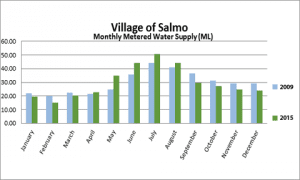With a strong commitment to water conservation, the Village of Salmo is an active WaterSmart community.
Sprinkling regulations are in place during the summer months requiring residents to restrict the times of “sprinkler watering”. Hand watering is permitted at any time, while sprinkling is restricted to the hours of 6:00 am to 9:00 am and 6:00 pm to 9:00 pm. “Sprinkler Watering” includes all overhead and spray type systems and micro and drip irrigation type systems.
For 2025, water conservation regulations per Bylaw #259, 1982 are in effect from July 1, 2025 to September 30, 2025, but may be extended or start earlier depending on drought conditions. BC Drought Information Portal.
Many communities across British Columbia are facing water shortages due to climate change. Part of being water smart is building resiliency against changing environmental conditions within our communities. Conserving water is easy and makes good sense from an economic, social, and environmental standpoint. Salmo sits atop pristine groundwater sources which must be respected and protected to ensure sustainability. Environmentally, these aquifers are sensitive to surface contamination and potential draw-down. Economically, the costs associated with operations, maintenance, capital upgrades, and pumping can be reduced though means of water conservation.
It is estimated that during peak demand most water use happens outdoors, as residents irrigate lawns and gardens. Salmo Village uses 3.5 times more water in the summer than in winter. Indoors, most of the water is used for flushing toilets, washing, and cleaning.

The graph shows that from 2009 to 2015 the Village of Salmo has experienced a 0.3% decrease in gross
community water demand.
The graph also shows how water use in Salmo increases in spring and summer. This is the period known as “peak demand,” when a community’s water use is at its highest.
Lawn watering is the main contributor to peak demand. By reducing peak demand,we reduce our
impact on water supply, distribution and treatment infrastructure and on the environment.
From 2009 to 2015, Water Smart communities have reduced gross annual demand by an average of 11%.
The Village of Salmo gets its drinking water from two ground water wells, which provide sufficient water supply for the Village’s current needs. Water use in Salmo increases dramatically in the summer-but this doesn’t mean we should only reduce outdoor water use. Rather, when we reduce our indoor water use, we reduce Salmo’s average daily demand.
Contact
Ph: (250) 357-9433
Fax: (250) 357-9633
Email: info@salmo.ca
Hours
Monday to Friday:
8:30 am – 4:30 pm
Closed: 12:00 pm – 1:00 pm daily